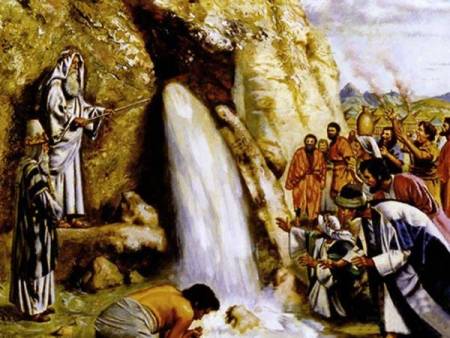Hypertypology
 Thursday, June 14, 2007 at 05:07PM
Thursday, June 14, 2007 at 05:07PM The Danger of Overused Typology
Typology has long been a favorite tool of Bible scholars and preachers. Rich details link Old Testament stories, events, people, places and things to the New Testament, adding strength and dimension to spiritual truths of the church age. When kept in perspective, typology enriches our knowledge and appreciation of the gospel. When it dominates the Biblical landscape, however, typology distorts or even destroys sound Bible teaching. The result is hypertypology, a term I have coined to describe this harmful view.
Through various shadows and figures, the Old Testament illustrates actual spiritual principles that we embrace today. For example, the brazen altar serves as a type of both Christ’s crucifixion and of repentance in the life of a new believer. A beautiful type of Christ is found in Joseph, the patriarch who became an Egyptian official in Pharaoh’s court because he played such a vital role in the salvation of the nation of Israel . Israel itself illustrates the church of Jesus Christ . Many of Israel 's experiences answer to the spiritual triumphs and tribulations the church faces today. “Now all these things happened unto them for ensamples: and they are written for our admonition, upon whom the ends of the world are come.” I Corinthians 10:11
Types add greatly to our understanding of the New Testament. For example, in the door to Noah’s ark, we see Jesus who said, “I am the Door.” As the door was to the ark, so Jesus is to the church. The kingship of David has powerful implications for Christ as the King of Kings, and the feasts of Israel shape our worship services and other practices of the present. Moreover, the use of types and shadows provides boundless inspiration and hope for believers today. The anointing oil, the sacrificial offerings, the unleavened bread, the lampstands and the rock that yielded water for the nation of Israel all hold great spiritual meaning for us. In fact, typology gives us great appreciation for the awesome intricacy with which the entire Bible fits together like a gigantic jigsaw puzzle. Pieces that baffle the beholder when pondered by themselves suddenly reveal a breath-taking view when they correspond with a New Testament truth. This process translates into the unity of the book, God’s masterpiece.
Hypertypology occurs when typology is taken too far. It has much the same effect as hypertension, or high blood pressure. We know that without blood pressure, an organism is either dead, or will soon die. On the other hand, too much blood pressure severely stresses the circulatory system and can cause a heart attack or stroke. Death may follow. In the same way, hypertypology threatens a balanced understanding of the Bible. Danger always lurks whenever we overuse legitimate types, when we exaggerate emphasis on the shadows and take away from the substance, when we make types rigid and singular in meaning, or when we subordinate the gospel to types rather than the types to the gospel. Such use of typology constitutes error and easily leads to false doctrine. Proper Biblical exegesis, however, demands that certain limitations be placed on types and shadows. Types cannot do more than they are designed to do: emulate the real, but not supplant it.
Consider the following dangers of hypertypology:
1) It permits the types to drive New Testament doctrine and theology, thus making the first covenant superior to the second. This clearly reverses the theme of Hebrews, both figuratively and literally.
2) It presumes unintended meanings from New Testament passages. It is improper, for example, to alter the interpretation of New Testament passages or definition of words because we think they conflict with the Old Testament.
3) It imposes unwarranted consequences upon New Testament events. For example, hypertypology makes Jesus into a lawbreaker because he violated certain provisions of the Sabbath.
4) It forces the New Testament back through the loop of the Old Testament. It other words, hypertypology would hold that New Testament doctrine only has meanings assigned to it by the Old Testament.
5) Hypertypology seduces the dubious scholar into a mistaken confirmation of his privately held theories. This is perhaps its greatest peril because anyone can espouse some theory, find an Old Testament type that supports it, and then artificially make the New Testament agree with the resulting doctrine.
Classic examples of hypertypology abound. Sabbath-keeping, the doctrine that demands the church today to observe the last day instead of the first day of the week, is probably the most familiar. The fourth chapter of Hebrews clearly shows this to be a type of “the rest” of the believer. The believer’s rest is not observing Saturday as a holy day, but in the baptism of the Holy Spirit. (Isaiah 28:11-12.) Also, keeping certain dietary laws which were mandatory for Israel but only represent spiritual truths for today's saints illustrate hypertypology. Other examples include the tabernacle and its furnishings, many personages in the Old Testament (e.g. Melchizidek) and historical events of Israel . The hypertypologist elevates these types to a position of higher significance than their spiritual meanings in the New Testament. In each of these instances, those who insist today that the church must either practice or at least subordinate the New Testament to the Old, teach in error.
Hypertypology produces some specific errors in reasoning. These errors stem from a very rigid insistence that the type must fit down to the most minute detail. This position creates impossible situations. One such erroneous teaching involves baptism. We know from I Corinthians 10:2 that the Red Sea passage during the exodus typified water baptism. Yet, the water did not actually cover the Israelites, even though the word baptism means to immerse. We also understand from several verses in Hebrews that every New Testament believer has access into the Holy Spirit. In the Old Testament tabernacle rituals, however, only the Priests, not the common people, entered into the holy place. Also, in the holy place, the shewbread was to be eaten only by the priests, yet David ate this contrary to law. (Matthew 12:4) In other words, the types were just that: types. When misconstrued as laws instead of symbols, they become distorted and even absurd.
New Testament believers proclaim the superiority of the New Covenant. The book of Hebrews provides all the clarity we need to be assured of this fact. “But now hath he obtained a more excellent ministry, by how much also he is the mediator of a better covenant, which was established upon better promises. For if that first covenant had been faultless, then should no place have been sought for the second. For finding fault with them, he saith, Behold, the days come, saith the Lord, when I will make a new covenant with the house of Israel and with the house of Judah ...For this is the covenant that I will make with the house of Israel after those days, saith the Lord; I will put my laws into their mind, and write them in their hearts...In that he saith, A new covenant, he hath made the first old. Now that which decayeth and waxeth old is ready to vanish away.” Hebrews 8:6-13. The writer to the Hebrews also deals extensively with this subject in the ninth chapter. The conclusion to which we must come is unavoidable: the New Testament is now the sole arbiter of our salvation and doctrine. Does this mean that the Old Testament has no value to us today? Not at all. It does mean that the Old Testament must be viewed through the lens of the New Testament, not the reverse. Whenever the Old Testament gets in the driver’s seat, doctrinal error always ensues.
Hypertypology can negatively impact New Testament doctrine by distorting the teaching and practices of the early church. The new birth experience, for example, involves the infilling of the Holy Spirit. If we were to make the Old Testament use of spiritual or angelic visitations superior to the historical references to the Holy Spirit in the New Testament, we would draw very different conclusions about this gift than we would by affirming the superiority of the New Testament. The Spirit of God moved upon individuals before the new covenant, but he did not take up residence within them as he did subsequent to the day of Pentecost. This would vastly alter the theology and experience of the Spirit baptism. Other aspects of New Testament teachings like the initial evidence truth in receiving the Holy Spirit, and a host of other authentic, Biblical experiences would be severly damaged if we were to make the New Testament subservient to the Old.
The Old Testament saints died in an imperfect (incomplete) state. Their salvation is intrinsically tied to the believers of the New Testament. Hebrews 11:40 clearly says, "God having provided some better thing for us, that they without us should not be made perfect." KJV. For us to revert back to the Old Testament for meaning and application of spiritual truths would be to go backwards from completion to incompletion. Not only would this fly in the face of divine revelation, it would be a shameful error. We must allow the Old Testament to continue to be the school master to bring us to Christ. We must not leave Christ to return to the school master. In Christ alone do we find the fulfillment of all things.

![omaha_steak_lobster[1].jpg](/picture/omaha_steak_lobster[1].jpg?pictureId=733065&asGalleryImage=true)


